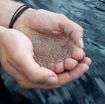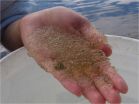(Press-News.org) New research on a number of Canadian lakes show that historical acid deposits as a result of industry have greatly reduced calcium levels in the water - dramatically impacting populations of calcium-rich plankton such as Daphnia water fleas that dominate these ecosystems.
Falling calcium levels mean Daphnia cannot get the nutrients they need to survive and reproduce, and are consequently consuming less food and becoming more susceptible to predators, leaving more algae for other organisms to feed on.
This has left a small jelly-clad organism called Holopedium to take advantage. Holopedium are plankton competitors of the Daphnia that use less calcium, as well as a jelly coat that affords them greater protection from predators.
Lakes across eastern Canada have seen Holopedium populations explode in the last thirty years; particularly in lakes in the province of Ontario that have seen a recent Eurasian invasion of the spiny water flea - which also favours hunting Daphnia, affording Holopedium even more room in these ecosystems to expand.
Researchers say the average population of these small invertebrate jellies in many Ontario lakes doubled between the mid-1980s and the mid-2000s. They warn that the increasing 'jellification' of Canada's lakes will prevent vital nutrients being passed up the food chain to fish stocks, as well as clogging filtration systems that help the lakes contribute drinking water to many residents in these areas.
The team used data from monthly surveys of lakes that recorded water chemistry and plankton populations for over 30 years, and used the latest statistical techniques to map all the cause-and-effect relationships in these ecosystems to determine that falling water calcium was causing the jelly boom. The results are published today in the journal Proceedings of the Royal Society B.
"As calcium declines, the increasing concentrations of jelly in the middle of these lakes will reduce energy and nutrient transport right across the food chain, and will likely impede the withdrawal of lake water for residential, municipal and industrial uses," said study co-author Dr Andrew Tanentzap, from the University of Cambridge's Department of Plant Sciences.
"In Ontario, 20% of government-monitored drinking water systems now come from landscapes containing lakes with depleted calcium concentrations that favour Holopedium, and this is only set to increase."
Historically, a lot of acid was deposited throughout the northern hemisphere due to industrialisation. The acid displaced calcium from soil, says Tanentzap. Over a long period, this process pushed all the calcium out of drainage areas that feed these lakes, causing dramatic declines in the water calcium levels.
"Pollution control may have stopped acid deposits in the landscape, but it's only now that we are discovering the damage wasn't entirely reversed," he said.
Daphniids have a heavily calcified exoskeleton, so need much higher levels of calcium and phosphorous. In low calcium water, Daphnia are much more vulnerable to at least one key predator - the larval phantom midge, or Chaoborus - as their ability to produce defences such as larger bodies, stronger exoskeletons and projecting neck teeth is compromised. Additionally, the Daphniids phosphorous requirements mean they need to eat a lot more.
Holopedium, however, have no exoskeleton, and require only half the phosphorous of Daphnia and just one-tenth the amount of calcium, and the jelly capsule in which Holopedium are contained largely protects them from the predators that live on plankton of this size.
Calcium loss isn't the only bad news for Daphniids. The team suggest that climate change is causing oxygen decline deep in the lakes, creating better conditions and increasing populations of larval midges - the main predator of Daphnia.
The team also investigated how far back the jellification of these lakes began. By analysing sediment cores and fossil records, they show that Holopedium have been steadily increasing ever since around 1850 - a time of early industrialisation and consequent acid deposit increases. But the process really gathered pace from the 1980s onwards.
"It may take thousands of years to return to historic lake water calcium concentrations solely from natural weathering of surrounding watersheds," said Tanentzap.
"In the meanwhile, while we've stopped acid rain and improved the pH of many of these lakes, we cannot claim complete recovery from acidification. Instead, we many have pushed these lakes into an entirely new ecological state."
INFORMATION:
People with airway diseases, including asthma and chronic obstructive pulmonary disease (COPD), have a higher incidence of inflammatory bowel disease, such as Crohn's disease and ulcerative colitis, according to the findings of a new study.
The research, which is published online today (19 November 2014) in the European Respiratory Journal, is the first population-based study to examine the association between airway diseases and the incidence of bowel disease. The news comes on World COPD Day, which aims to improve awareness and care of COPD.
The results showed that ...
Researchers from the University of East Anglia (UEA) are a step closer to enhancing the generation of clean energy from bacteria.
A report published today shows how electrons hop across otherwise electrically insulating areas of bacterial proteins, and that the rate of electrical transfer is dependent on the orientation and proximity of electrically conductive 'stepping stones'.
It is hoped that this natural process can be used to improve 'bio batteries' which could produce energy for portable technology such as mobile phones, tablets and laptops - powered by human ...
People taking part in this year's Flusurvey, the UK's biggest crowd-sourced study of influenza will for the first time be offered a swab to confirm if their symptoms are caused by a flu virus or not as part of a new collaboration with i-sense. Data from social media and internet searches will also be combined with Flusurvey, allowing flu trends to be monitored across the UK more accurately and earlier than ever before.
Flusurvey scientists at the London School of Hygiene & Tropical Medicine will analyse weekly information relating to symptoms, provided in an online questionnaire ...
David King, clinical lecturer in paediatrics at the University of Sheffield, says medical professionals and consumers need to be aware that such devices "have no proved use in safeguarding infants or detecting health problems, and they certainly have no role in preventing [sudden infant death syndrome] SIDS."
Wearable devices for infants are a growing industry worldwide. Devices that attach to a newborn baby to monitor its vital signs are marketed by several US companies at a cost of around $200 to $300 to give parents "peace of mind" about their baby's health.
One ...
The authors say their findings are applicable to law enforcement work outside the US and support the view that stressful work related activities can "trigger" sudden cardiac death.
Law enforcement is a dangerous occupation. In 2011-2012, the fatality rate among US patrol officers was 15-16 per 100,000 full time workers - about 3-5 times the national average for private sector employees.
Some evidence suggests that cardiovascular disease is higher among police officers than the general population, but data about the impact of specific on duty activities ...
Observational studies have suggested that lower levels of vitamin D are associated with increased mortality, but whether low vitamin D concentrations are a cause of increased mortality or simply a consequence of poor health is thus unclear.
This is an important question, say the authors, as millions of people worldwide are regularly taking vitamin D supplements, presumably with the aim of preventing diseases and hopefully living longer.
Genetic variants have been reliably associated with circulating concentrations of vitamin D, a marker of vitamin D status. So a research ...
Boston, MA -- Police officers in the United States face roughly 30 to 70 times higher risk of sudden cardiac death (SCD) when they're involved in stressful situations--suspect restraints, altercations, or chases--than when they're involved in routine or non-emergency activities, according to a new study from Harvard School of Public Health (HSPH) and Cambridge Health Alliance (CHA). It is the first study to provide data that demonstrates the impact of stressful duties on on-duty SCD.
The researchers also found that physical training activities--which police don't consider ...
ANN ARBOR, Mich. -- A national effort to shave minutes off emergency heart attack treatment time has increased the chance that each patient will survive, a new study suggests. But yet the survival rate for all patients put together hasn't budged.
It seems like a paradox. But wait, say the authors of the new report: the paradox vanishes with more detailed analysis of exactly who has been getting this treatment.
Far more people are getting emergency angioplasty and stents for heart attacks now than before. That number now includes more people with more complicated health ...
Barcelona, Spain: A phase I trial of the first drug designed to inhibit the cancer-causing activity of a mutated enzyme known as isocitrate dehydrogenase (IDH) 1, which is involved in cell metabolism, has shown clinical activity in patients with advanced acute myeloid leukaemia (AML) with the IDH1 mutation.
Professor Daniel Pollyea, M.D. will tell the 26th EORTC-NCI-AACR [1] Symposium on Molecular Targets and Cancer Therapeutics in Barcelona, Spain, today (Wednesday) that early results from the phase 1 clinical trial of the drug AG-120, an oral, selective and potent inhibitor ...
Barcelona, Spain: Researchers have found that patients with an advanced form of kidney cancer, for which there is no standard treatment and a very poor prognosis, respond well to a combination of two existing anti-cancer drugs.
Dr Ramaprasad Srinivasan, head of the Molecular Cancer Therapeutics Section, Urologic Oncology Branch, of the National Cancer Institute in Maryland, USA, will tell the 26th EORTC-NCI-AACR [1] Symposium on Molecular Targets and Cancer Therapeutics in Barcelona, Spain, today (Wednesday) that the combination of bevacizumab and erlotinib produced ...





